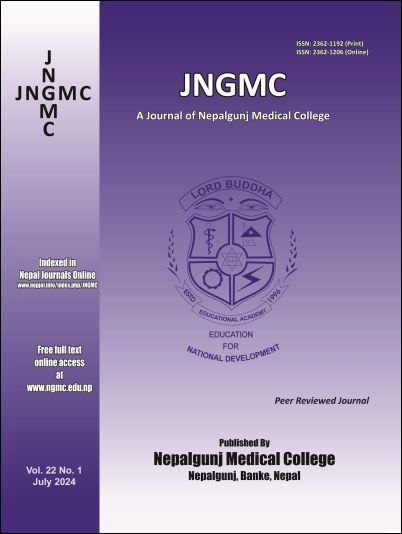Accessibility of Finding Tuberculosis Case Actively, Separate Safely and Treat Effectively (FAST) Strategy for Early Detection of Suspected and Symptomatic Tuberculosis Patients: A Hospital Based Quantitative Study
DOI:
https://doi.org/10.3126/jngmc.v22i1.69729Keywords:
FAST strategy, Gene xpert machine, Multi drug resistance (MDRtb), Tuberculosis (TB)Abstract
Introduction: Tuberculosis is a contagious disease which has always been a challenge over the course of human history. It is known to spread mostly from persons with undiagnosed and suspected tuberculosis cases. Diagnosing tuberculosis in an early stage with effective treatment is one of the best ways to reduce the burden of tuberculosis. Finding cases Actively, Separate safely and Treat effectively (FAST) Strategy in Nepal, is a rapid diagnostic tool for rapid tuberculosis case detection.
Aims: To access tuberculosis case Actively, Separate safely and Treat effectively (FAST) strategy for suspected and symptomatic tuberculosis patients coming to the hospital for early case detection and also to identify patient’s health care behaviour, technical barrier during surveillance.
Methods: An observational quantitative study of active cough surveillance was carried at an entry point of FAST corner of Nepalgunj Medical College Teaching Hospital, Banke from April 2023 to December 2023. Scrutinized data was obtained by purposive sampling method with sample size 128 from FAST corner.
Results: Maximum cases belonged to the aged group 65 and above having lower middle to lower socioeconomic status. Most of them were from joint family with contact history of tuberculosis in 35 (27.3) % of total cases. Out of total cases, 72 (56.25) % were confirmed with tuberculosis. Among those confirmed tuberculosis cases, multi drug resistance TB was found in 6 (4.7) %. Uses of mask was found significant (P< 0.05) in our study although number of these health care behaviour were less appropriate. Pneumonia was a significant association 17 (P = 0.004) with tuberculosis patient. Insufficient volunteers, and limited Gene xpert machine were major barriers to implement FAST strategy screening in Hospital.
Conclusion: FAST strategy is feasible tool in high tuberculosis burden healthcare settings in Nepal. However, the technical and behavioral factors should be managed to ensure an effective approach.
Downloads
Downloads
Published
How to Cite
Issue
Section
License

This work is licensed under a Creative Commons Attribution-NonCommercial-NoDerivatives 4.0 International License.
- Attribution - You must give appropriate credit, provide a link to the license, and indicate if changes were made. You may do so in any resonable manner, but not in any way that suggests the licensor endorses you or your use.
- Non Commercial- The materials cannot be used for commercial purposes.
- No Derivatives- If the material is remixed or transformed or built upon, the modified material cannot be distributed.




